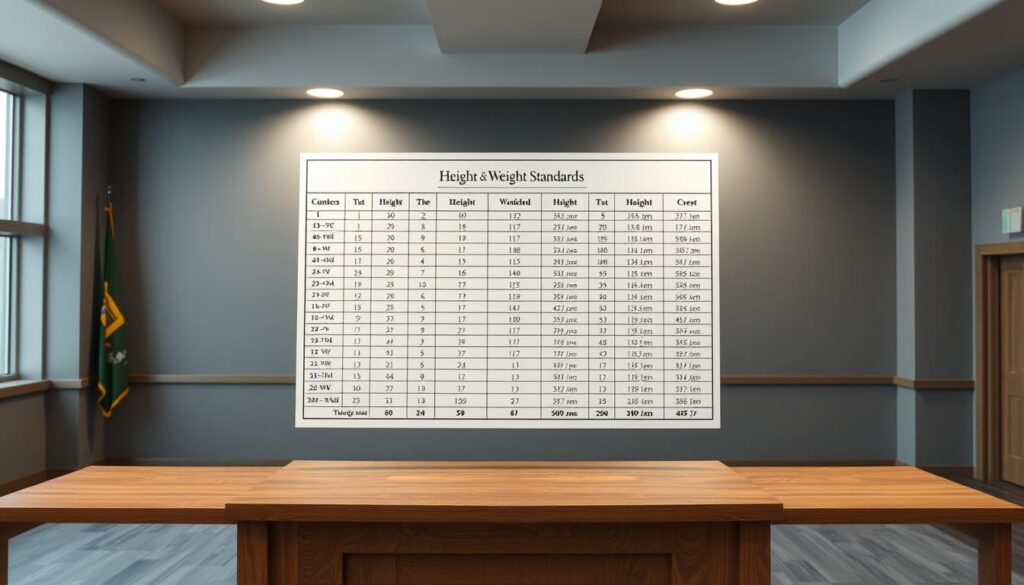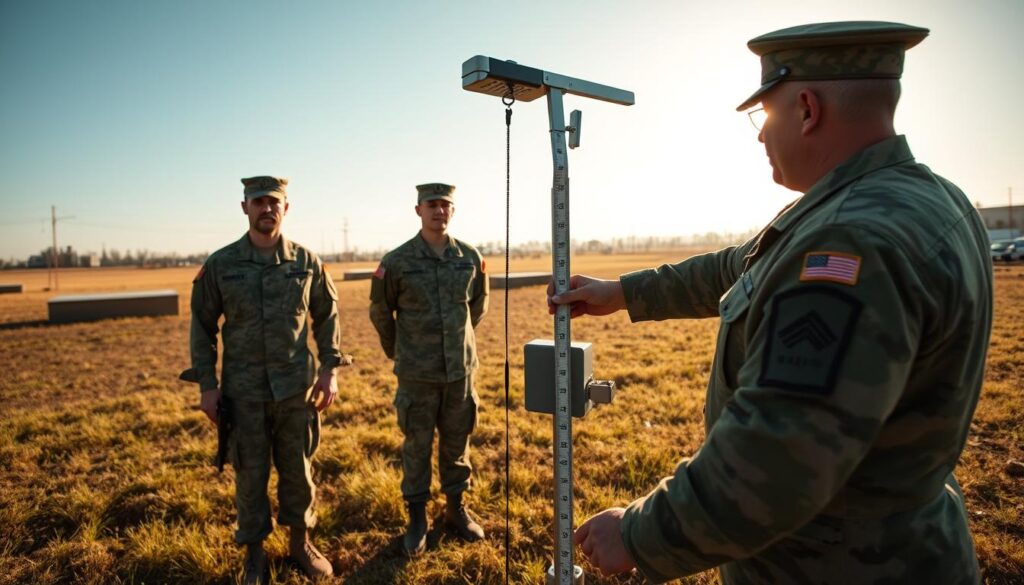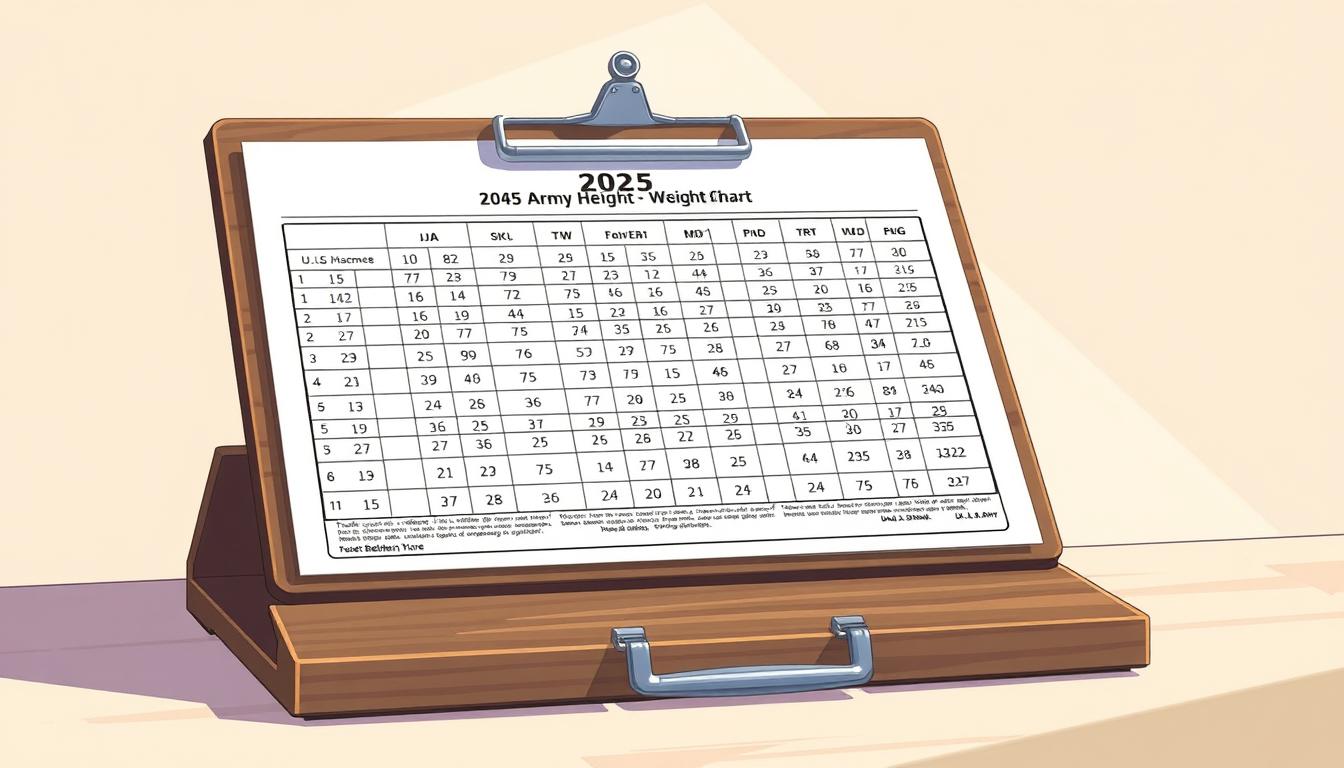Do physical standards affect how well military personnel do their jobs? The US military has strict rules to keep troops in top shape.
The Army Height and Weight Chart 2025 is key to a strong military. It sets the bar for soldiers’ health.
Knowing these standards is vital. It helps soldiers meet their job’s demands and work well together.
Key Takeaways
- The Army Height and Weight Chart 2025 outlines the physical standards for military personnel.
- These standards are crucial for ensuring soldiers’ overall health and readiness.
- Meeting these standards is essential for soldiers to perform their duties efficiently.
- The chart provides a benchmark for evaluating soldiers’ physical fitness.
- Physical fitness is a critical component of military preparedness.
Overview of Army Height and Weight Regulations
The Army has strict height and weight standards to keep its military ready. These rules are key for soldiers to do their jobs well and stay ready for duty.
It’s very important to follow these standards. Soldiers who fit the height and weight requirements for army roles can handle their jobs better. This lowers injury risks and boosts performance.

Importance of Height and Weight Standards
The Army height and weight standards make sure soldiers can do their jobs. These rules keep the military ready by making sure everyone is fit and able to perform their duties well.
For more details on meeting these standards, check out our guide on the 2023 Army Height and Weight Calculator. It offers a step-by-step guide to understanding and meeting the Army’s height and weight requirements.
Historical Context of Army Regulations
The soldier weight regulations have changed a lot over time. The Army has updated its height and weight standards to match new physical needs and societal changes. Knowing this history helps us understand today’s rules and their role in modern military operations.
Looking at how these standards have evolved shows the Army keeps updating them. This ensures they stay relevant and effective in keeping a strong and ready military.
The 2025 Height and Weight Standards
In 2025, the Army updated its height and weight standards for everyone. This change aims to keep soldiers fit and healthy.
The new rules still focus on height and weight as key fitness indicators. But, they’ve made adjustments for different ages and genders.
Overview of Changes in 2025
The 2025 updates consider age and gender differences in height and weight. The maximum weight for men and women has been updated to match current health standards.
For example, the maximum weight for men and women in different age groups has changed. The Army also created detailed charts to help soldiers understand their standards.
| Age Group | Height (inches) | Max Weight for Men (lbs) | Max Weight for Women (lbs) |
|---|---|---|---|
| 17-20 | 60-64 | 132-163 | 120-149 |
| 21-27 | 65-69 | 144-179 | 128-159 |
| 28-39 | 70-74 | 156-194 | 136-170 |
Age and Gender Considerations
The new standards take into account age and gender differences. They provide separate guidelines for different groups.
“The Army’s height and weight standards are designed to promote overall health and readiness. By adjusting these standards to reflect current health guidelines, we can better support our soldiers’ well-being.” – Army Fitness Directive
For example, a 25-year-old male soldier can weigh more than a female of the same age and height. This is because men generally have more muscle.
These updates show the Army’s dedication to keeping its soldiers fit. They also recognize the unique needs of its diverse members.
How to Measure Height and Weight Properly
To meet Army standards, precise measurements are key. Soldiers must have their height and weight checked often. Accurate measurements are crucial for following Army standards, including the height and weight requirements for army.
Guidelines for Accurate Measurements
Accurate measurements are vital for ensuring soldiers meet Army standards. To measure height, soldiers should stand on a flat surface without shoes. They should have their heels together and back straight against a stadiometer or similar device.
For weight measurements, soldiers should be weighed on a calibrated scale. This should be done in the morning after using the restroom and before eating, following soldier weight regulations.
| Measurement Type | Correct Method | Common Mistakes |
|---|---|---|
| Height | Stand straight against a stadiometer without shoes | Wearing shoes, slouching |
| Weight | Use a calibrated scale in the morning before eating | Wearing heavy clothing, not calibrating the scale |

Common Mistakes to Avoid
Common mistakes include not standing up straight, wearing shoes, or not removing heavy clothing or accessories. To comply with the army height and weight chart 2025, pay attention to these details. This helps avoid incorrect measurements.
By following these guidelines and avoiding common mistakes, soldiers can ensure their measurements are accurate. This compliance with height and weight requirements for army keeps them ready for service.
Implications of Weight Standards on Recruitment
The new army weight standards 2025 have big changes for recruitment. It’s important for both those interested in joining and military leaders to understand these changes.
Impact on Enlistment Eligibility
Meeting the army height standards and weight requirements is key for joining. Potential recruits must meet these to qualify. For more on these standards, check out our guide on army height and weight standards.
The strict height and weight regulations help ensure recruits are ready for military training. This affects who can join and how the military looks at potential recruits.
Considerations for Different Military Roles
Different military jobs have different physical needs. This means military height requirements and weight standards can vary. For example, jobs that need lots of physical activity might have stricter standards.
It’s crucial to know these role-specific requirements if you’re thinking about joining. It helps you prepare and choose the right job for you.
Alternatives to Height and Weight Measurements
The Army looks at more than just height and weight to check if a soldier is fit. They know that these basics are just the start. They need a deeper look to make sure soldiers are ready for duty.
Body Fat Percentage Standards are a key part of this. The Army Body Composition Program (ABCP) checks body fat percentage. This gives a clearer picture of a soldier’s fitness, beyond just their weight.
Body Fat Percentage Standards
The ABCP uses neck and waist circumference to guess body fat percentage. This method is more accurate. It looks at more than just weight.
For example, a soldier with lots of muscle might weigh more but not be overfat. The ABCP makes sure these soldiers aren’t unfairly judged.
The Role of Physical Fitness Tests
The Army also uses Physical Fitness Tests to check soldier fitness. These tests include running, push-ups, and sit-ups. They show if a soldier can handle tough tasks.
These tests give a full view of a soldier’s fitness. By adding body fat percentage checks, the Army makes sure soldiers are both fit and ready for duty.
These new ways of checking fitness show the Army’s dedication to keeping its soldiers in top shape. By mixing body fat percentage and physical fitness tests, the Army makes sure its soldiers are ready for anything.
Health Implications of Height and Weight Standards
Following the army’s height and weight standards has big effects on soldiers. It impacts their physical health and mental well-being. These standards are set to ensure soldiers can do their jobs safely and effectively.
Effects on Physical Performance
Being within the army’s height and weight ranges is key for a soldier’s physical abilities. Soldiers who meet these standards tend to have better endurance and agility. This is because the standards help prevent injuries during duty.
Physical Performance Metrics are closely linked to these standards. For example, a soldier’s BMI affects their running and lifting abilities. The army uses tests to check fitness, and meeting the height and weight standards is essential for passing these.
| Physical Attribute | Impact on Performance | Relation to Height/Weight Standards |
|---|---|---|
| Endurance | Essential for long missions and tasks | Directly related; optimal weight enhances endurance |
| Agility | Critical for tactical maneuvers | Indirectly related; muscle composition matters |
| Strength | Necessary for combat and equipment handling | Related; appropriate weight and muscle mass are crucial |
Psychological Impact on Soldiers
The mental effects of following these standards are significant. Soldiers who find it hard to meet these standards may feel stressed and have low self-esteem. The pressure to fit in can harm their mental health.
The army knows the importance of supporting soldiers in their fitness journey. It offers programs to help them reach and stay within the required standards. These programs focus on physical training and nutrition advice.
By understanding the health impacts of these standards, the army can improve its support for soldiers. This helps enhance their performance and overall quality of life.
Resources for Army Personnel and Applicants
The Army has many resources to help meet the height and weight standards. These resources support individuals in reaching the new weight standards and improving fitness.
Accessing Official Regulations
Army regulations are available online on the Army’s website. They detail height and weight needs, and how to measure body fat.
Support for Weight Management
The Army offers weight management support. This includes fitness training and nutrition advice. These help keep a healthy weight and boost fitness.
Using these resources, Army members and applicants can meet standards and stay fit.


